
Title
Habatsu no Chugoku seiji (Factions in Chinese Politics - From Mao to Xi)
Size
396 pages, A5 format, hardcover
Language
Japanese
Released
August 20, 2023
ISBN
978-4-8158-1131-0
Published by
The University of Nagoya Press
Book Info
See Book Availability at Library
Japanese Page
This book elucidates the mechanisms underlying Chinese politics from the perspective of factions. By clarifying these mechanisms within the Chinese Communist Party (CCP) and political conflicts, this book highlights the role and importance of factions in Chinese politics. Furthermore, it argues that factional competition creates policy diversity within the Communist Party, which is the source of the adaptability and resilience of the CCP regime.
This book examines the CCP as the ruling party of a one-party dictatorship and unravels the mechanisms of factional politics within the CCP through the enthusiastic application of insights from comparative politics. If it only demonstrated the importance of factions in Chinese politics, this work would be a mere confirmation of the findings of previous studies. This book emphasizes that the rise and fall of factions is the driving force behind political conflicts and political change. It also shows that factional competition enhances the adaptability of the CCP and contributes to the resilience of authoritarian regimes. The significance of this book is that it presents a dynamic view of factions overlooked by both traditional Chinese and comparative political studies and makes a theoretical contribution to the key issue of the persistence of the authoritarian regime.
Using a comparative historical analysis, the book combines theoretical construction and historical empirical analysis. The introductory chapter presents a theoretical framework of the life cycle of factions. After a brief explanation of the characteristics of factions in China in Chapter 1, the book develops case studies from Chapters 2 to 6. By chronologically analyzing the activities of each faction dynamically from the perspective of their rise and fall and their linkage with political conflicts, the book depicts the mechanism behind the activities of the CCP factions and clarifies their gradual changes. Since the cases are carefully selected in terms of time and the nature of factional ties, this book is rather comprehensive, and it is an ambitious attempt to analyze the history of the CCP within the framework of factions.
The significance of this book is as follows. First, by analyzing the period of 100 years from the founding of the CCP in 1921 to the present, this book offers the reader valuable insight into the overall picture of elite politics in the CCP and changes over time. Second, it provides an in-depth analysis of individual case studies. Each case is an excellent independent political history analysis. Third, this book emphasizes its theoretical contributions to comparative political studies. By using a comparative historical analysis and actively applying the insights of comparative politics (e.g., patron–client relations, principal–agent relations, and the coalition theory), this book places China in a comparative context. By discussing the adaptability of the CCP, this book contributes to the debate on the survival and resilience of authoritarian regimes, which is one of the most important topics in contemporary comparative politics.
(Written by LI Hao, Associate Professor, Graduate Schools for Law and Politics / 2024)
Table of Contents
Faction and Political Conflict: Theoretical framework
Chapter 1
Factions in China: Beiyang Warlords, the Kuomintang and the Chinese Communist Party
Chapter 2
Mao Zedong’s Strategy of Faction Manipulation: Chinese Revolution and the Soviet Faction, Zhou Enlai and Liu Shaoqi
Chapter 3
The Lin Biao Clique and the Cultural Revolution: Mao’s Personal Dictatorship and Jiang Qing
Chapter 4
The Petroleum Clique and the “Western Leap Forward”: The Failure of Hua Guofeng’s Economic Development Strategy
Chapter 5
Chen Yun, Economic Conservatives and the “Reform and Opening”: Reconsidering “Chief Architect of Reform and Opening” Deng Xiaoping
Chapter 6
Jiang Zemin’s Shanghai Clique and the Transformation of Socialism: Political Institutionalisation and Hu Jintao, Xi Jinping
Conclusion
The Chinese Communist Party and Factions: Comparative Perspectives



 Find a book
Find a book


